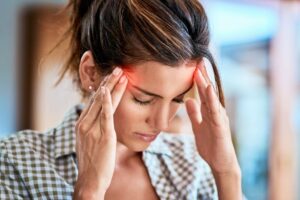By Dr. Stephen Knoyer, DC, CCSP
Migraines are very common and can be debilitating to the people that experience them. Migraines are the 3rd most prevalent illness in the world and nearly 1 in 4 U. S. households includes someone with a migraine. 12% of the population suffers from migraines with roughly 90% have a family history. Migraines are the 6th most disabling illnesses in the world and 1.2 million visits to the emergency room are acute migraine attacks.
The symptoms and types of migraines range from mild to severe. People will report slight discomfort on one side of the head or severe sharp pain that incapacitates the individual. The typical migraine has 5 stages that occur. The first is the premonitory phase, aura, headache or main attack, resolution and recovery or postdrome. The first stage is the premonitory phase also known as the warning phase which is where the mental and/or physical symptoms that occur before the migraine. These have been known to be mood changes, feeling thirsty, craving sweet foods, fatigue or stiff neck. This stage lasts 1-24 hours.
The aura is not always present and can wide a range of symptoms. People report changes in speech, hearing and smell. Changes in vision is the most common common where dark spots, coloured spots, bright sparkles/stars or lines are in their vision. Numbness, tingling, dizziness or vertigo can also happen but are less frequent. Changes in memory, fear, confusion, temporary paralysis and fainting are also rare but has been reported. These symptoms all occur prior to the headache but in children these can happen at the same time. Finally these all can occur without the headache happening. This stage lasts 5-60 minutes.
The headache or main attack phase is often described as severe or unbearable pain. The pain is normally one side of the head, throbbing in sensation and typically made worse with any movement. The pain can spread from the one area to the entire head. This stage is known for nausea, sensitivity to light and/or sound. The symptoms can last up to 24 hours. These can also be referred to as pathological migraines.
The resolution phase is the next stage of migraines. They normally fade away slowly but occasionally will stop suddenly. Crying and if the person becomes ill has been known to reduce the symptoms faster. Sleep is the most common way to reduce the symptoms and children respond the best with sleep as a means of reducing the pain.
The final stage is the recovery or postdrome stage and this stage can last for a few hours or up to a couple of days. These are often described as a “hangover” in sensation and often mirror the symptoms in the beginning. If lost of energy was in the warning stage then the person my feel full of energy now.
The treatment of migraines usually consist of medications or manual therapies( soft tissue, stretching, manual spinal manipulation and dry needling). In severe cases medication maybe the only thing that provides any relief for the person. Soft tissue massage, spinal manipulation and therapeutic exercises all have been shown to reduce the severity of pain. In some cases the migraine has resolved shortly after treatment. In 2011 a study from The Journal of Headaches reported “ that massage therapy, physiotherapy, relaxation and chiropractic spinal manipulative therapy might be equally efficient as propranolol and topiramate in the prophylactic management of migraine.”
- Symptoms and stages – The Migraine Trust. Retrieved October 05, 2016, from https://www.migrainetrust.org/about-migraine/migraine-what-is-it/symptoms-and-stages/
- Chaibi, A., Tuchin, P. J., & Russell, M. B. (2011). Manual therapies for migraine: A systematic review. Retrieved October 05, 2016, from https://www.ncbi.nlm.nih.gov/pmc/articles/PMC3072494/
Migraine Facts – Migraine Research Foundation.” Migraine Research Foundation. N.p., n.d. Web. 05 Oct. 2016.
About the Author
Dr. Bross is the owner of Elite Chiropractic and Sport. He serves as a Certified Chiropractic Sports Practitioner (CCSP) and Certified Strength and Conditioning Specialist. His unique approach to individualized patient care is based on the evaluation and treatment of the “whole” person.
Dr. Bross is a leader in the promotion of health and wellness. He has accumulated an extensive knowledge of the musculoskeletal and nutritional components of the human body. He is skilled in the Graston Technique, Active Release Technique, and Sports Medicine.






